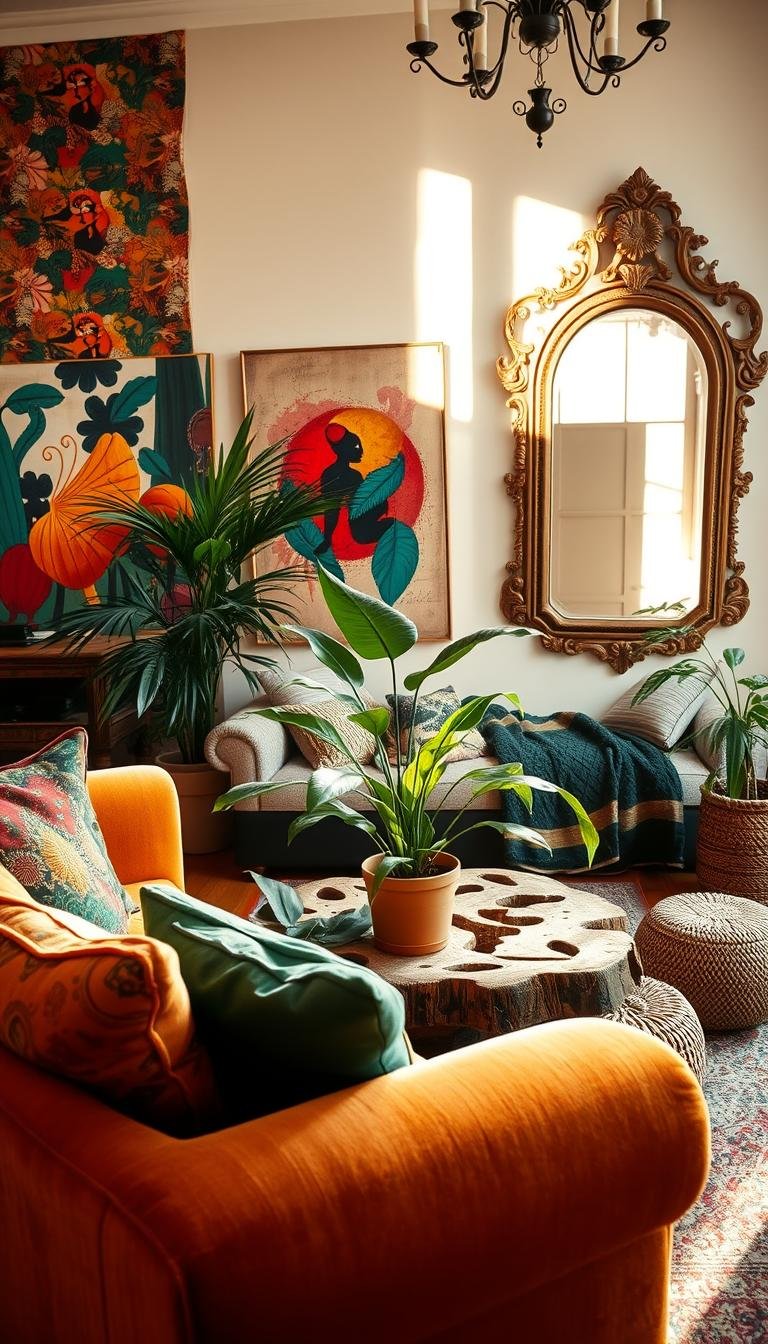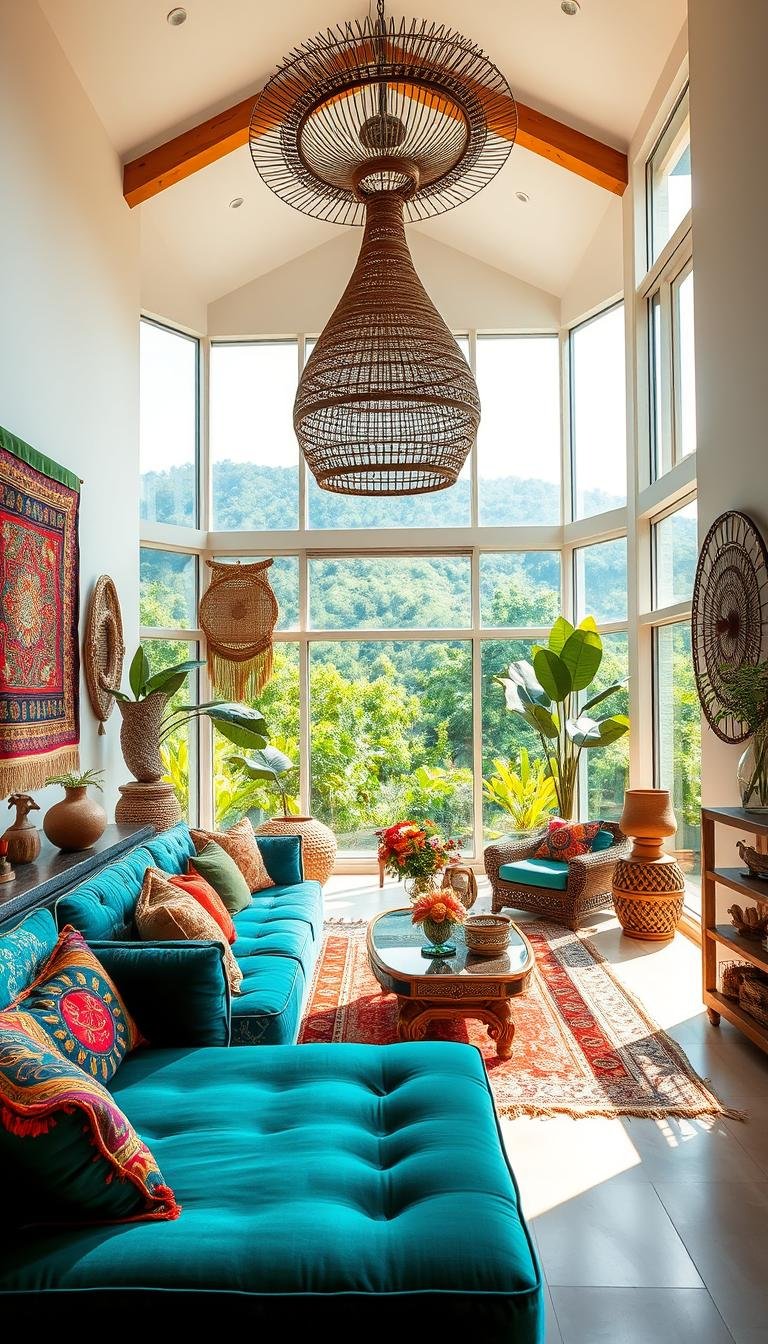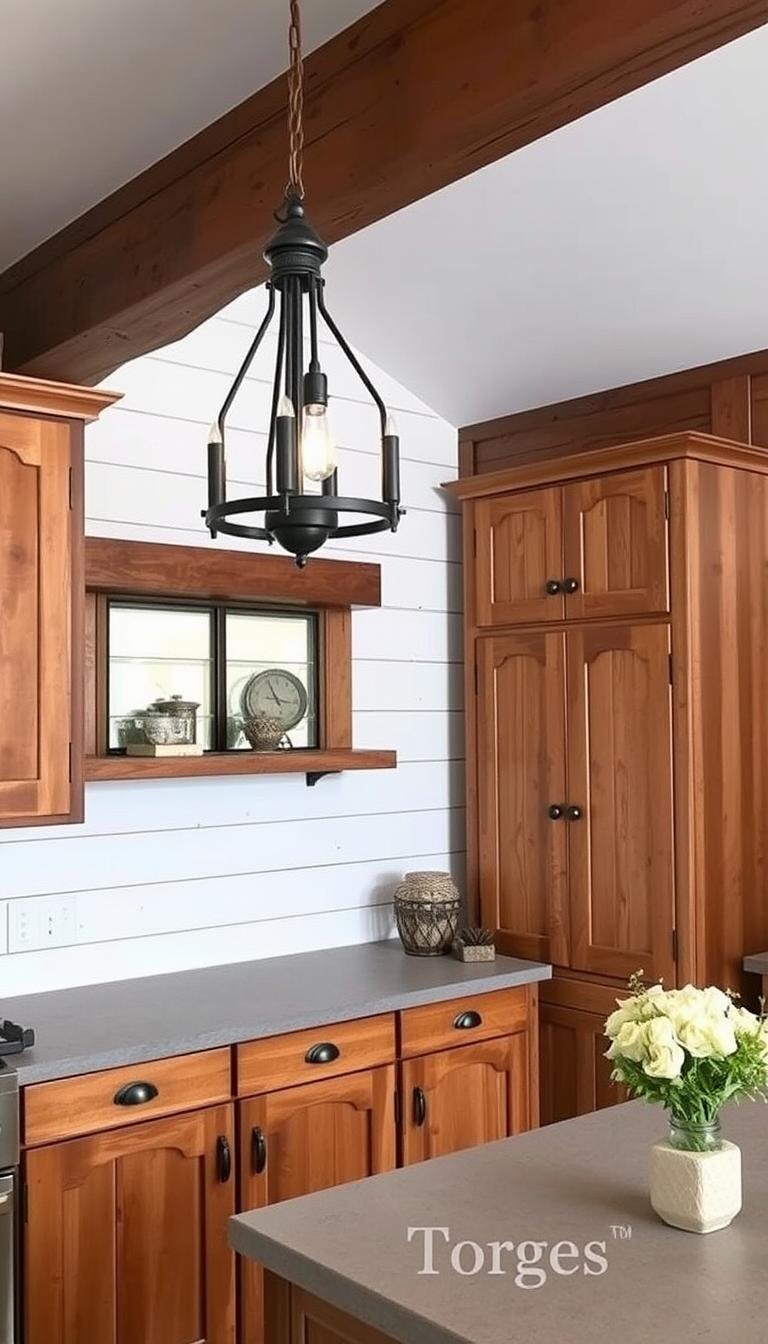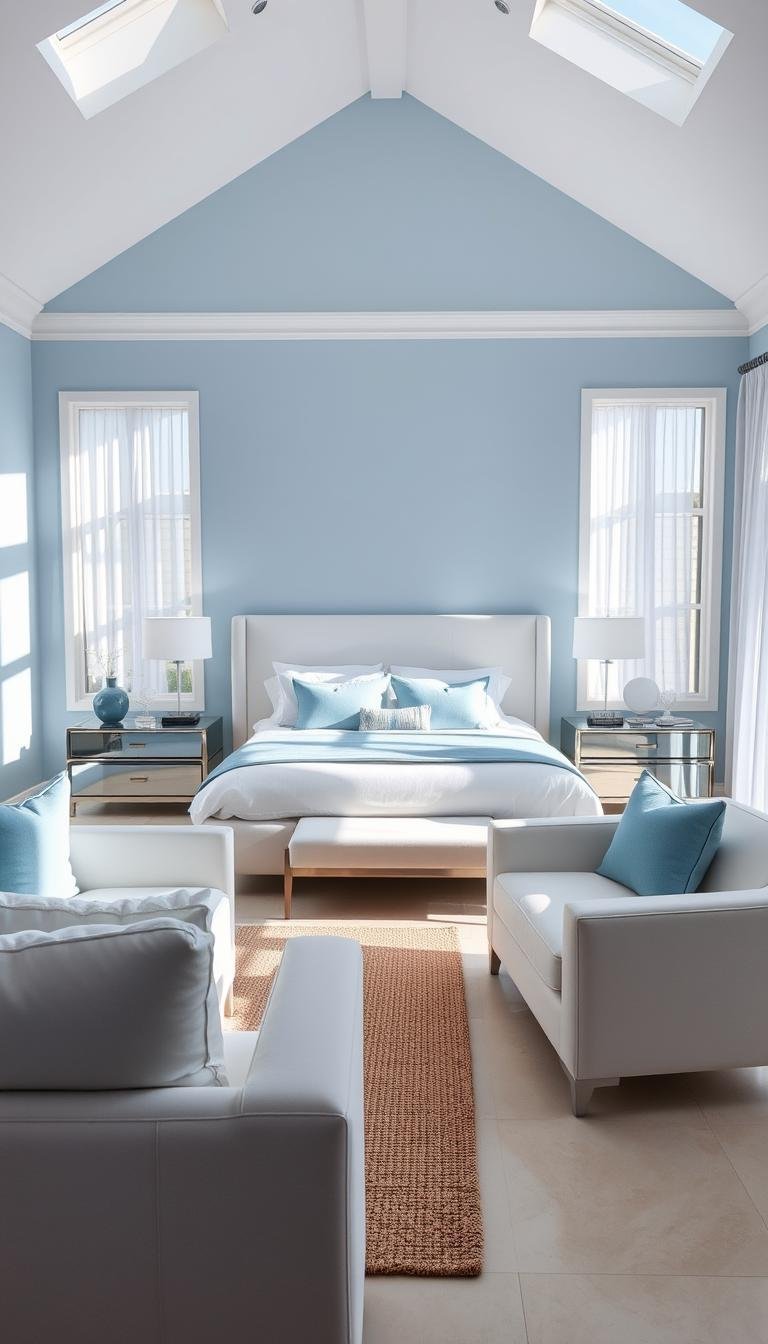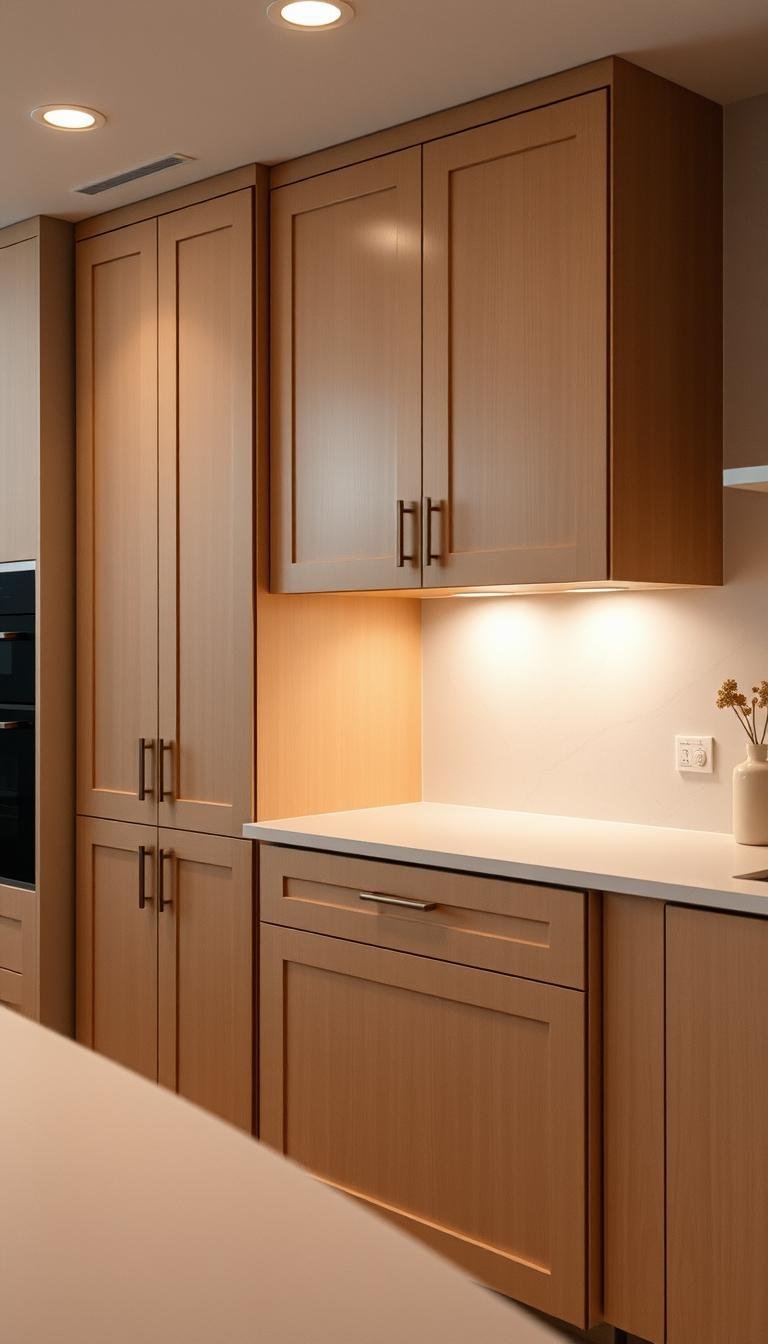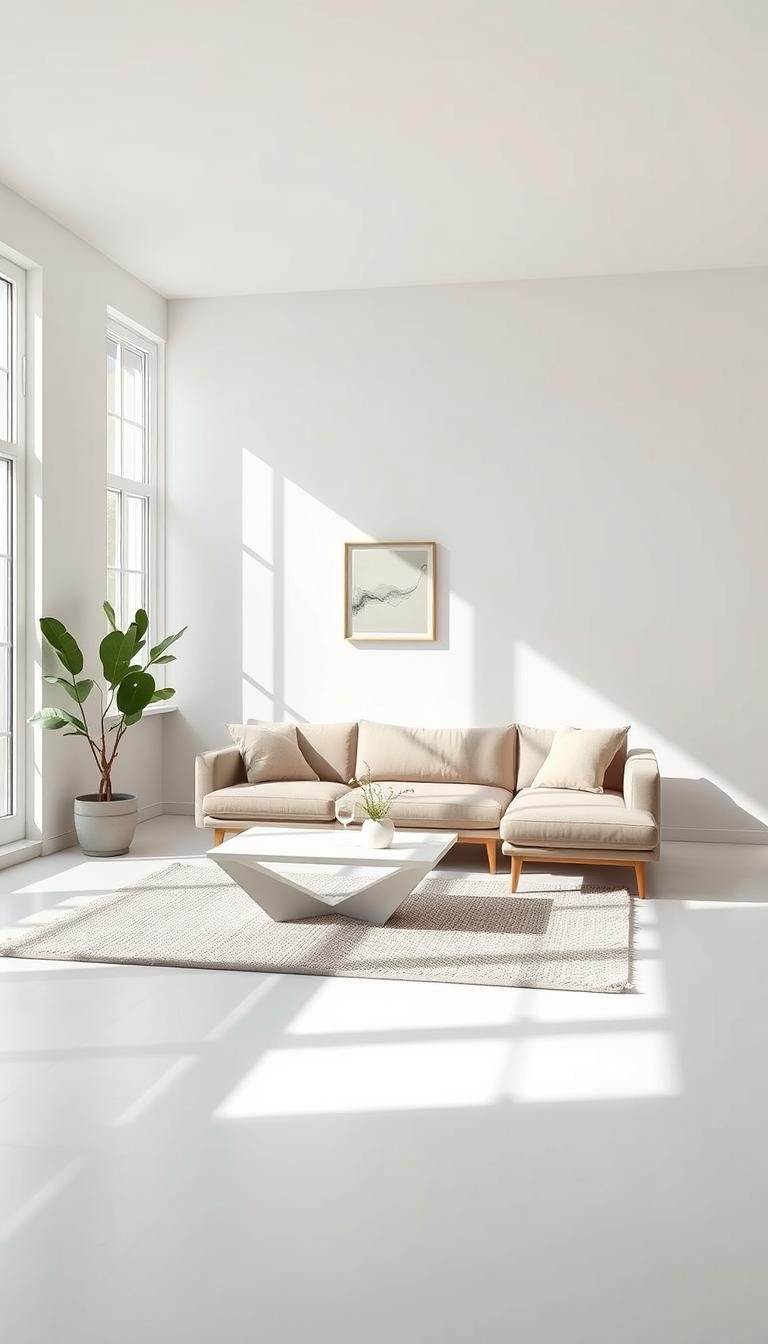This post may contain affiliate links. If you click and buy, we may earn a small commission at no extra cost to you. Learn more.
I’m excited to share with you the Afrohemian decor trends that are changing home decoration! This style mixes the rich cultural heritage of Africa with the free-spirited essence of Bohemian design.
By blending African design influences with Bohemian style, you can make a unique and welcoming space. It reflects your personality. Afrohemian decor is all about embracing cultural heritage and comfort.
Contents
- 1 The Essence of Afrohemian Decor: Where Heritage Meets Comfort
- 2 Historical Journey: How Afrohemian Decor Evolved
- 3 Essential Afrohemian Decor Elements for Your Home
- 4 Color Psychology in Afrohemian Spaces
- 5 Textiles and Patterns: The Soul of Afrohemian Style
- 6 Creating Comfortable Gathering Spaces with Cultural Significance
- 7 Authentic Art and Artifacts: Curating with Respect
- 8 DIY Projects to Personalize Your Afrohemian Space
- 9 Conclusion: Embracing Afrohemian Style as Cultural Appreciation
The Essence of Afrohemian Decor: Where Heritage Meets Comfort
Afrohemian style is more than a trend. It’s about mixing cultural roots with modern living. It blends African design with Bohemian freedom and creativity.
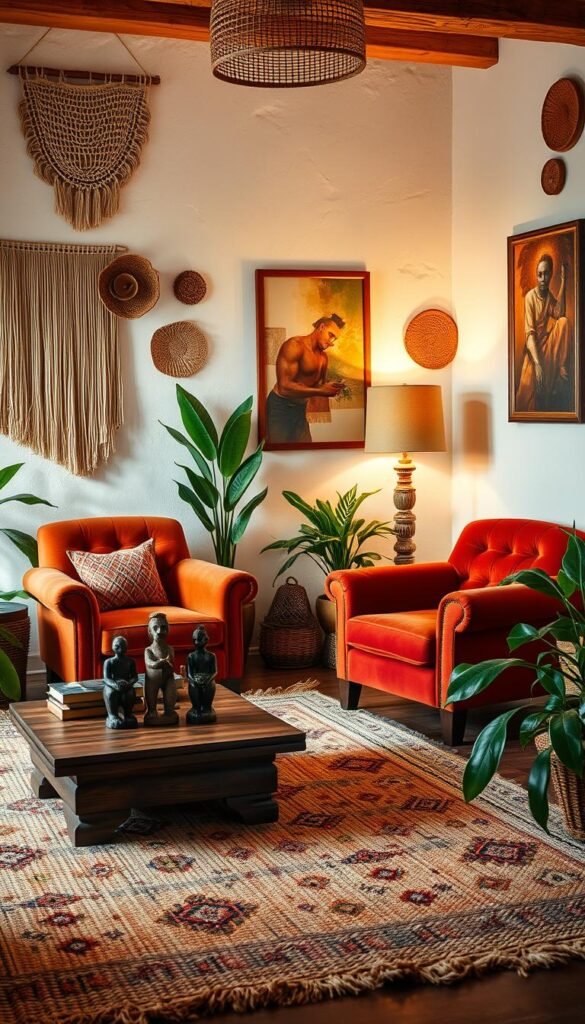
The Cultural Foundations of This Emerging Style
Afrohemian decor comes from two cultures:
African Design Influences
African design adds history and tradition. It includes vibrant patterns and wood carvings. These elements make modern homes feel connected to their roots.
Bohemian Philosophy and Aesthetic
The Bohemian spirit brings creativity to Afrohemian decor. It’s about living freely and showing it in your home. This means using eclectic furniture and global influences.
Why Afrohemian Style Resonates in Modern Homes
Homeowners love Afrohemian style for its unique mix. Here’s why:
- Cultural Significance: It connects you to your heritage.
- Personal Expression: It lets you show your personality through decor.
- Comfort and Warmth: It combines tradition with modern comfort, making homes cozy.
In short, Afrohemian decor is more than a style. It’s a way of life that honors heritage and modern comfort. As we explore it, we’ll see how it’s changing homes.
Historical Journey: How Afrohemian Decor Evolved
To grasp Afrohemian decor, we must look at its African roots and the Bohemian movement. This mix of cultures and styles has created a unique look. It’s both inspired by the world and deeply connected to heritage.
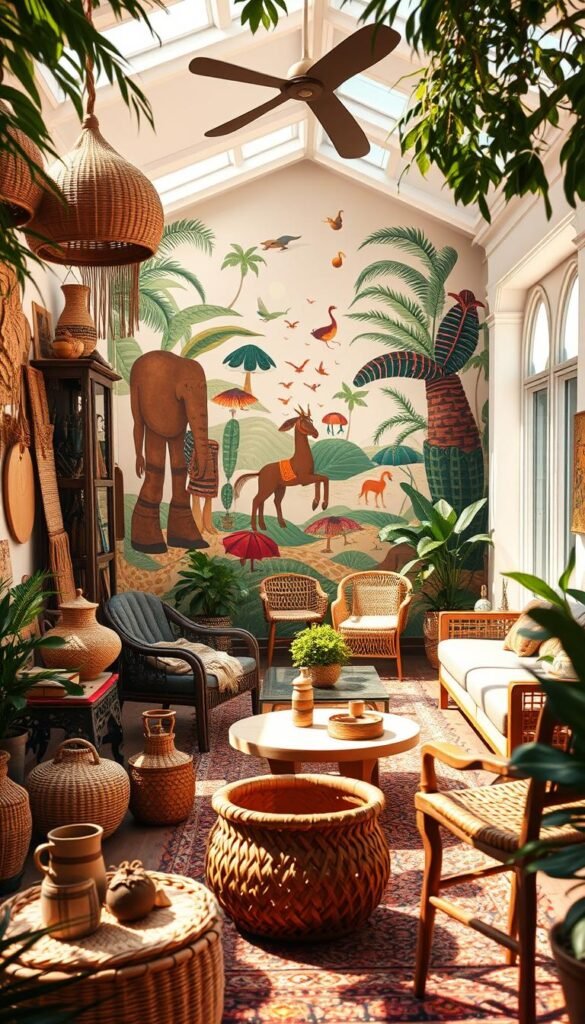
Traditional African Design Elements Through the Ages
For centuries, traditional African design has shaped decor. It features detailed patterns, bright colors, and symbols. Textiles like mud cloth from Mali and Kente fabric from Ghana are key to the Afrohemian look.
- Intricate patterns that tell stories and convey cultural values
- Vibrant colors that evoke emotions and symbolize different aspects of African culture
- Symbolic motifs that represent community, spirituality, and heritage
The Bohemian Movement and Its Global Impact
The Bohemian movement has greatly influenced global design. It celebrates creativity and individuality. This style, combined with African design, has formed Afrohemian decor.
Key influences include:
- A mix of vintage and global elements
- An emphasis on comfort and self-expression
- A blend of different cultural and artistic traditions
Essential Afrohemian Decor Elements for Your Home
Afrohemian decor mixes heritage with comfort. It’s about blending old traditions with modern comfort. The key is combining bold statement pieces with subtle accents.
Must-Have Pieces That Define the Style
To get the Afrohemian look, you need a few essential items. These items capture the style’s unique essence.
Statement Furniture
Statement furniture is vital in Afrohemian decor. Look for pieces that show African craftsmanship. Think intricately carved wooden chairs or vibrant, hand-woven sofas.
These items bring cultural heritage to your space. They also spark interesting conversations.
- Hand-carved wooden furniture
- Vibrant, hand-woven textiles
- Unique, culturally-inspired pieces
Signature Accessories
Signature accessories add a Bohemian touch to Afrohemian decor. Think colorful, eclectic textiles or traditional African masks. Handmade pottery is also great.
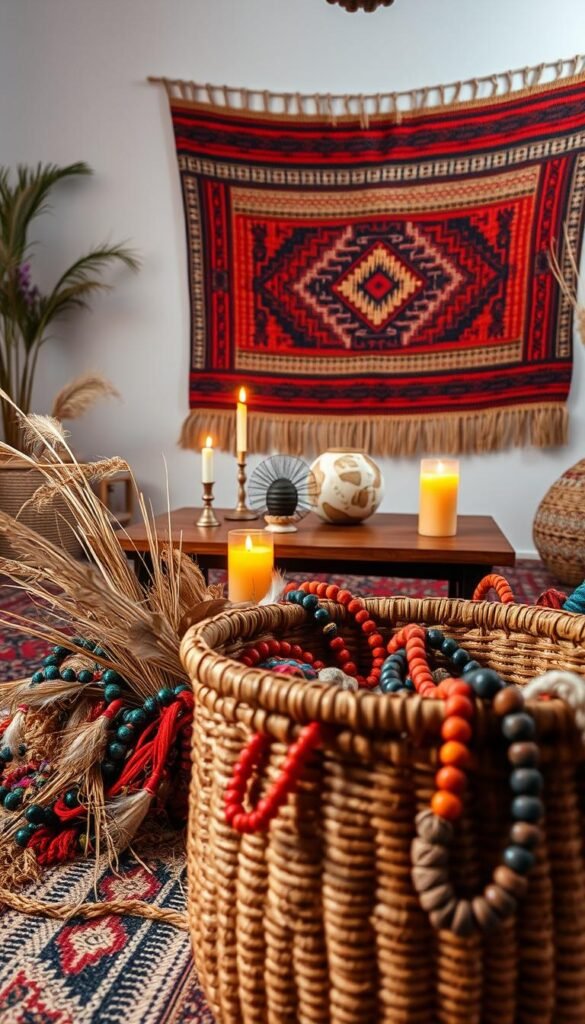
Balancing Statement and Subtle Elements
Finding a balance is key in Afrohemian decor. You need both bold statement pieces and subtle accents. This balance keeps your space harmonious.
Pair bold items with more neutral pieces. For example, a vibrant rug goes well with neutral walls and furniture. This way, your bold pieces stand out without overwhelming the space.
Color Psychology in Afrohemian Spaces
In Afrohemian decor, color is key. It makes a space feel connected to culture and uplifting. The right colors can make a room feel cozy or peaceful.
Earth Tones as Foundation Colors
Earth tones like terracotta, sienna, and umber are the base of Afrohemian spaces. They add warmth and a sense of connection to the earth. These colors remind us of African soil and link us to nature.
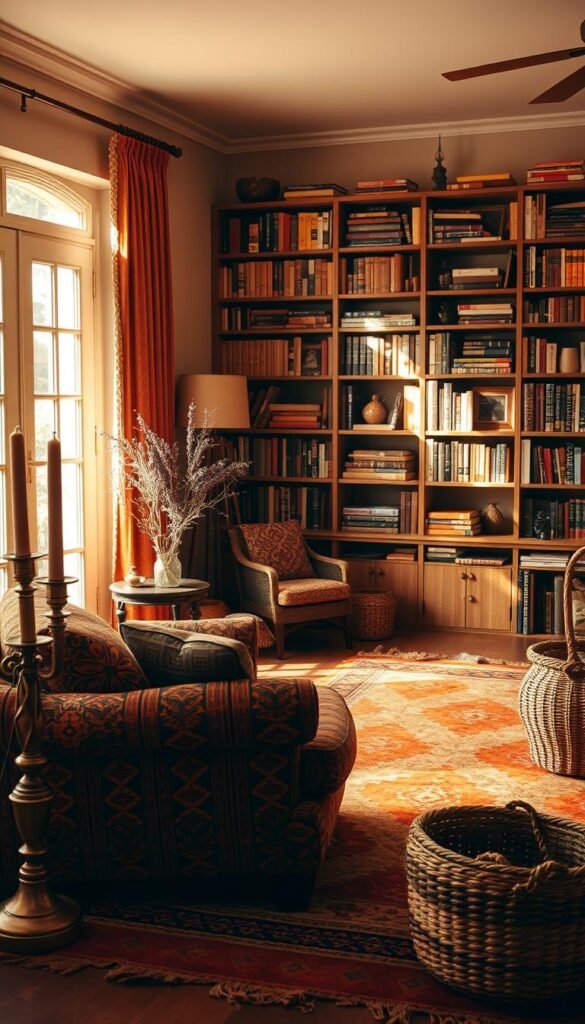
Vibrant Accents and Their Cultural Significance
Vibrant accents, like kente cloth prints or Adire designs, add cultural depth. They are beautiful and carry deep cultural stories. These accents tell of heritage and identity.
Creating Color Harmony in Mixed-Influence Spaces
To mix colors well in Afrohemian spaces, balance earthy tones with bright accents. Use the 60-30-10 rule: 60% of the room is a main earth tone, 30% a secondary color, and 10% an accent. This balance makes the space look good and feel right.
Knowing how colors work and using the 60-30-10 rule helps. You can make an Afrohemian space that’s stunning, culturally rich, and uplifting.
Textiles and Patterns: The Soul of Afrohemian Style
The heart of Afrohemian decor lies in its stunning textiles and patterns. They blend tradition with modern chic perfectly. I’m excited to share my favorite African textiles and how to mix them with Bohemian fabrics for a unique look.
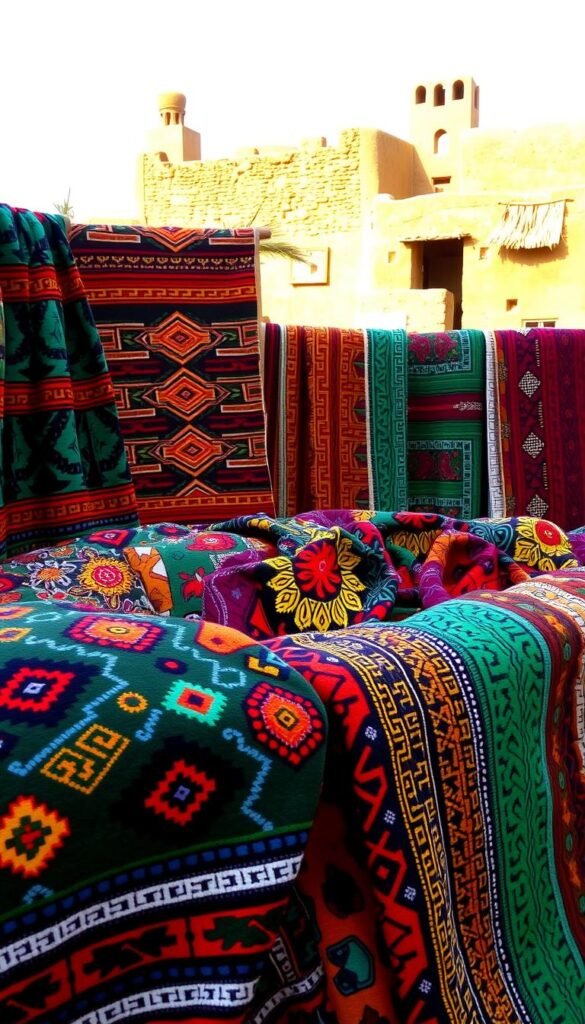
Traditional African Textiles Worth Investing In
African textiles are not just beautiful; they carry deep cultural significance. Here are a few traditional African textiles worth investing in:
Mud Cloth (Bògòlanfini)
Mud Cloth, or Bògòlanfini, is a traditional Malian textile. It tells stories through its designs and symbols. This fabric adds beauty to any room and is a piece of cultural heritage.
Kente and Ankara Fabrics
Kente cloth from Ghana and Ankara prints from West Africa are iconic. They are known for vibrant colors and patterns. Kente cloth is symbolic, with each color representing different aspects of life and culture. Ankara prints are celebrated for their versatility and bold designs.
Bohemian Textiles That Create Perfect Pairings
To create an Afrohemian space, blend African textiles with Bohemian elements. Pair Mud Cloth with Moroccan tiles or Indian block-print fabrics. The key is to find common ground in colors or patterns and build from there.
- Moroccan tiles for a pop of color and texture
- Indian block-print fabrics for a mix of patterns
- Vintage kilim rugs for added warmth
The Art of Pattern Mixing Without Overwhelming
Pattern mixing is an art that requires balance. Start with a neutral base and then add statement pieces. For instance, pair a vibrant Ankara print with more subdued tones in your furniture and decor. The goal is to create harmony, not chaos.
“The art of mixing patterns lies in understanding the balance between contrast and cohesion.”
By carefully selecting and mixing textiles, you can create a space that is not only beautiful but also rich in cultural significance.
Creating Comfortable Gathering Spaces with Cultural Significance
Gathering spaces are the heart of any home. I’m here to guide you in making areas that are cozy and culturally significant. Afrohemian decor is more than looks; it’s about creating spaces for connection and belonging. By adding elements from African traditions and bohemian life, your home becomes beautiful and meaningful.
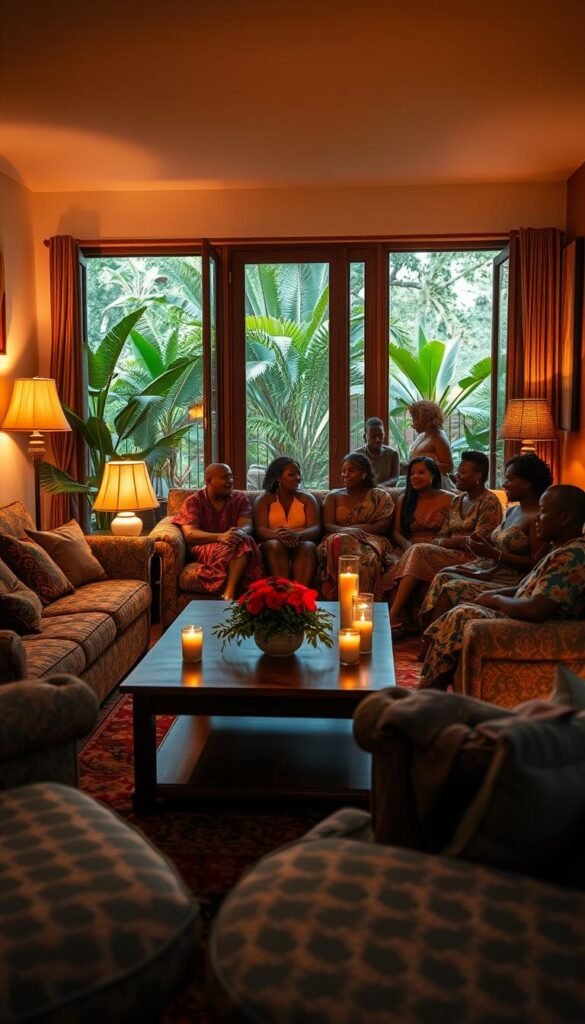
Floor Seating Arrangements Inspired by African Traditions
African traditions inspire the floor seating in Afrohemian decor. These setups encourage people to gather and talk, making your space warm and welcoming. Use plush rugs, low sofas, and colorful pillows to bring this style to life. It honors African culture and brings people together.
- Use plush area rugs to define the seating area
- Incorporate low-slung sofas and poufs for relaxed seating
- Add colorful pillows and throws to enhance the visual appeal
Conversation Pits and Community-Centered Layouts
Conversation pits and layouts that focus on community are key in Afrohemian decor. These designs make it easy for people to talk and connect. Add a statement piece or a fire pit to make your space even more inviting.
Key elements to consider:
- Circular or U-shaped seating arrangements
- A focal point, like a statement art piece or fire pit
- Comfortable, inviting textiles and furnishings
Balancing Privacy and Togetherness in Your Design
Afrohemian decor values community but also privacy. Use furniture that serves more than one purpose, like storage ottomans or daybeds with curtains. Room dividers or screens can also help, creating separate areas in open spaces. This way, you get both community and personal space.
“The art of creating a home is not just about the physical space, but about crafting an environment that nurtures both the body and the soul.”
Authentic Art and Artifacts: Curating with Respect
Exploring Afrohemian decor highlights the importance of authentic art and artifacts. These elements add beauty and tell our story. It’s about respecting and celebrating the cultural heritage of each piece.
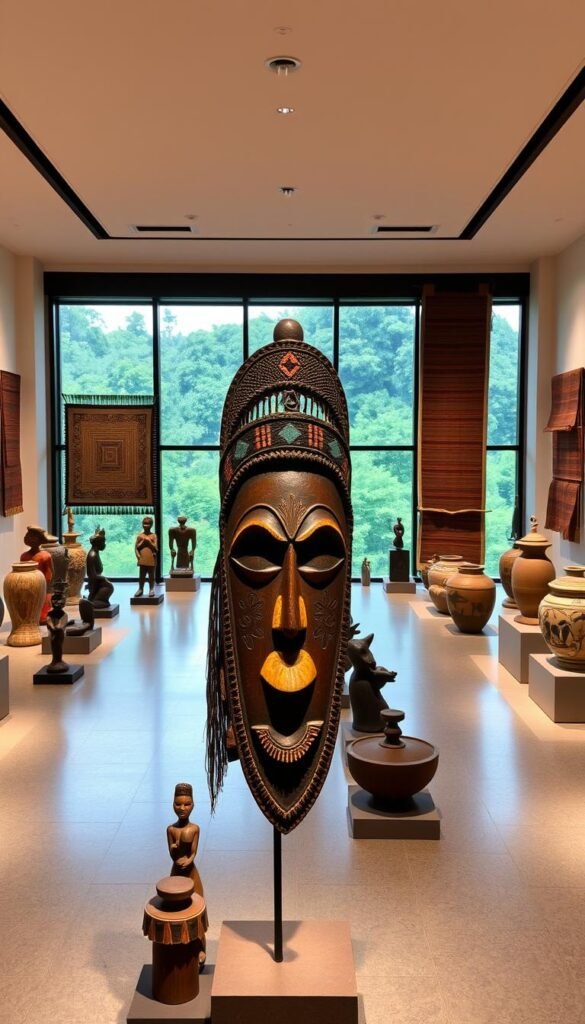
Ethically Sourcing African Art and Decor
It’s vital to source African art and decor ethically. Look for pieces with clear origins, obtained legally, and with fair compensation for artists. I enjoy visiting local markets and galleries that support African artists and communities.
These places offer a chance to learn about each piece’s history and support cultural heritage. Here are some tips for ethical sourcing:
- Buy directly from artists or local cooperatives
- Research the seller for fair trade policies
- Learn about the piece’s history and significance
Supporting Contemporary African and Diaspora Artists
Supporting contemporary African and diaspora artists brings fresh perspectives to your space. They often mix traditional techniques with modern themes. This creates unique, culturally significant, and visually striking pieces.
Look for these artists on online platforms, social media, and art fairs. Some notable artists include:
- Kehinde Wiley
- Lynette Yiadom-Boakye
- Glenn Ligon
Creating Meaningful Displays That Tell Your Story
After curating your collection, display your art and artifacts to tell your story. Group pieces by theme, color, or artist background. I mix vintage with contemporary to reflect my journey.
Create a gallery wall with traditional masks, contemporary paintings, and textiles. Balance the display for a curated look. This way, your space celebrates African culture and shows your style.
DIY Projects to Personalize Your Afrohemian Space
Creating your own Afrohemian decor is a fun way to show off your creativity and love for culture. I’m excited to share some easy and inspiring DIY ideas to make your space unique!
Textile-Based Projects for Beginners
Textiles are key in Afrohemian decor, and making them yourself is very rewarding. Here are a couple of easy projects for beginners:
No-Sew Pillow Covers
Give your living room a new look with no-sew pillow covers. Use bright African prints or bohemian fabrics for a bold statement. Just tie the fabric around the pillow with knots or ties. It’s a quick and easy way to add color and texture.
Simple Wall Hangings
Make a beautiful wall hanging with African fabric, a wooden dowel, and some basic knots. This adds cultural heritage to your walls and sparks interesting conversations. You can also add natural elements like shells or beads for a bohemian touch.
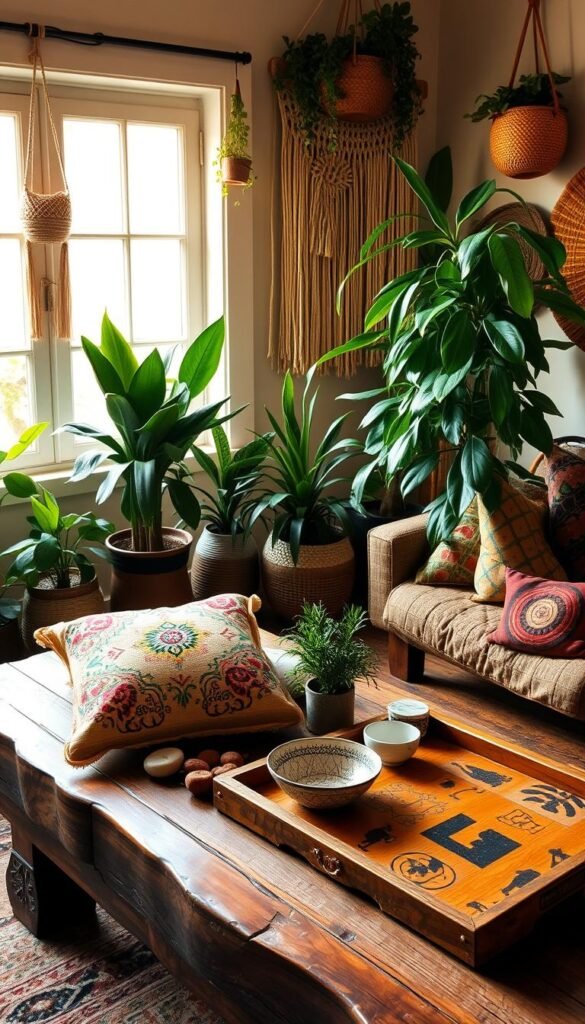
Furniture Upcycling with Cultural Motifs
Upcycling old furniture is good for the planet and adds character to your space. Look for pieces that match African or bohemian styles. Then, give them a new look with paint or hardware inspired by culture. For example, turn an old wooden chair into art by adding African patterns or bright colors.
Creating Personal Art Inspired by African Design
Art is a great way to make your space personal and tell your story. Use African designs as inspiration for your art, whether it’s paint, fabric, or mixed media. You can make abstract pieces that show the energy of Afrohemian culture or art that honors African heritage. This is your chance to be creative and expressive, making your space truly yours.
Conclusion: Embracing Afrohemian Style as Cultural Appreciation
As we wrap up our exploration of Afrohemian decor, I’m thrilled to see you embracing it in your home. This style combines African design, Bohemian flair, and personal touches. It creates a space that shows off your taste and respects the cultural roots that inspire you.
Afrohemian style celebrates cultural exchange, connecting communities and traditions. When you decorate with Afrohemian elements, remember to honor their cultural importance. This approach shows deep respect for the heritage behind each piece.
Embracing Afrohemian style is more than just decorating. It’s about joining a conversation on cultural identity, community, and design’s power to unite. Let’s keep celebrating Afrohemian decor and the connections it brings!
To bring you cozy inspiration more efficiently, we sometimes use AI to assist in content creation — but every word and idea is carefully shaped by our team. See our AI Disclosure for more info.

